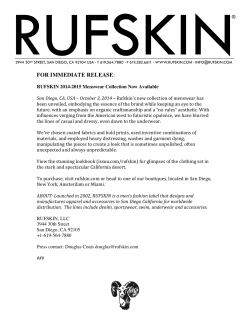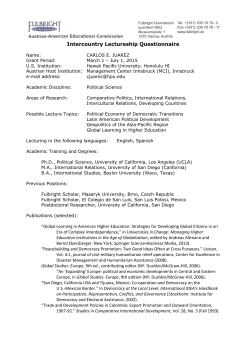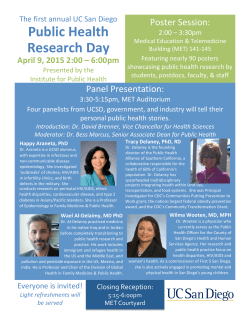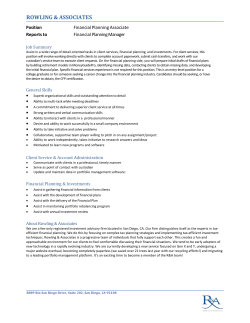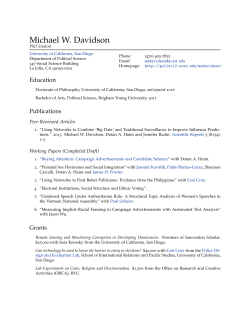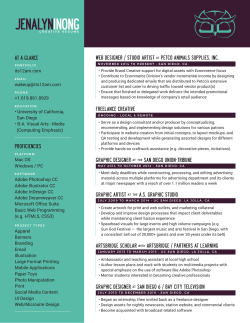
Quality of Life Dashboard 2015
The San Diego Regional 2015 Quality of Life Dashboard 6th Annual Table of Contents Page Rating 6 Indicator 1 What You Can Do 2 Key Findings Cross-border Economic and Environmental Metrics 34 Sponsors Climate Change 38 Acknowledgements 39 Photo credits 40 Organizations Consulted Air Quality 4 Unhealthy Days for Sensitive Groups N 8 About Equinox Center Border Region Greenhouse (GHG) Emissions 10 Economic Prosperity 12 Economic Prosperity 14 Electric Vehicles 16 Energy Unemployment Rate Our mission Equinox Center is a non-partisan, independent, regional entity that advances innovative solutions to balance regional growth with our finite natural resources. Our mission is to ensure a healthy environment, strong economy and civic engagement for the San Diego region. What we do >>Inspire >>Inform >>Engage Why we do it How we do it >>Protect our environment >>Promote strong economy >>Enhance quality of life >>Policy Research >>Outreach and Advocacy >>Civic Engagement Venture Capital Funding Electric Vehicle Rebates Improved from the previous year Worsened from the previous year Renewable Energy 18 Energy 20 Housing Residential Electricity Consumption N Housing Affordability 22 Land Use 24 Transportation Park Access Transportation Choices <1% or insignificant change from previous year N Data not published in previous year’s Dashboard What You Can Do Implement Our Ideas for Change How you can make a difference Have an idea for change? Let us know on Twitter (@EquinoxCenter) or Facebook (www.facebook.com/EquinoxCenter) and use #SDQoL. Are you concerned about issues like climate change, water conservation, reducing pollution or preserving our beaches and region’s natural beauty? Are you concerned about transportation, available jobs or the future of San Diego’s economy? For a digital version of the publication, visit: www.equinoxcenter.org/Regional-Dashboard The Dashboard contains “ideas for change,” and you can make them happen. Encourage your employer, elected officials, landlord, or your neighbor to implement these changes. Champion Our Cause Stay informed about key issues facing our region. Follow us on Facebook and Twitter. Want to receive our newsletter? Write us at communications@equinoxcenter.org. Invest In Our Programs Your financial support allows us to continue our research, expand our network of support and ensures a high quality of Life for the San Diego region. To make a tax-deductible donation, visit www.equinoxcenter.org/donate. 26 Transportation Highway Vehicle Miles Traveled (VMT) Invite Others to Engage 28 Waste Invite your friends, colleagues and business associates to join our online community, attend our events or donate to Equinox Center. 30 Water Water Use If you are in your 20’s or 30’s and you want to be more civically engaged, join our Leaders 2020 network to meet other inspiring young leaders. 32 Water To sign up, email communications@equinoxcenter.org. Landfill Waste Disposal Join Leaders 2020 Beach Closures and Advisories www.facebook.com/EquinoxCenter www.facebook.com/SanDiegoLeaders2020 @EquinoxCenter @SDLeaders2020 www.equinoxcenter.org Key Findings Measuring What Matters Equinox Center’s principal publication, The San Diego Regional Quality of Life Dashboard, combines data collection and analysis with research and outreach strategy to advance intelligent policy in the San Diego region. Drawing from strong relationships with environmental groups, government and the business community, Equinox Center is able to provide a balanced snapshot of the region’s quality of life using credible data, clear metrics and benchmarks. The Dashboard tracks our region’s progress on critical, interlinking quality-of-life issues and provides examples of where things are working and ideas for how we can improve. Key Findings from the 2015 San Diego Regional Quality of Life Dashboard We researched quality of life indicators in the Baja region of Mexico for a new Border Region section. Pg. 6 Housing is back! One driver of quality of life in our region is housing affordability. How much do you spend to rent or own? Pg. 20 Increasing water consumption, despite the drought, tops our list of concerns. How is your community conserving? Pg. 30 Unemployment continues to fall in San Diego County. Are you employed in one of our strong and growing local industries? Pg. 10 On-road transportation is the greatest GHG contributor in our region, yet 3/4 of us drive alone every day. How are you getting to work? Pg. 24 Different data, updated indicators and new endeavors are included in the 2015 Dashboard. What’s your favorite? Tell us on Twitter or Facebook. What Gets Measured Gets Managed Better YOUR GUIDE TO THE DASHBOARD 1 idea for change Whether an indicator is trending up or down, we can always make improvements. “One idea for change” offers practical solutions and policy ideas for improving quality of life in the San Diego region. Charts and infographic diagrams help illustrate how San Diego County compares to state benchmarks, to other regions and how San Diego County communities compare to each other. Bright Spots highlight progress and achievements that have been made toward improving San Diego’s quality of life. Equinox Center’s Dashboard provides the analytical foundation to enhance our region’s quality of life. We are hopeful that policy makers, businesses and residents use our research to make fact-based decisions, improving the sustainability of our economy and environment. Using the Dashboard as a tool to bring innovation and action to the dialogue on how to ensure a prosperous economy and healthy environment, we all can help move the needle in the right direction for San Diego County residents. 2 San Diego Quality of Life Dashboard 2015 3 Air Quality Air Quality Unhealthy Days for Sensitive Groups How are we doing? Between 2012 and 2013, the number of unhealthy air quality days for sensitive groups in San Diego County decreased from 21 to 17. San Diego had far fewer unhealthy air days than Los Angeles, but the map shows children’s asthma hospitalization rates varied across the County. 11 How we compare Why is it important? idea for change Conscientious Resident Buy locally sourced produce and food items. Purchasing these items from farmer’s markets and community supported agriculture improves air quality by decreasing ground shipping to supermarkets. >> Everyday the average individual inhales at least 2,906 gallons of air. Some are more sensitive to poor air quality, typically seniors, children and those with respiratory illnesses. >> In the San Diego region, a majority of air pollutants come from vehicle emissions. When engines burn fuel, they release chemicals such as nitrogen oxides (a precursor to smog), metals, acids, benzene and formaldehyde. Bright Spot Number of Unhealthy Air Days in San Diego County for Sensitive Groups (Selected Counties, 2013) 100 90 80 70 60 50 40 Children’s Asthma Hospitalization Rates by Zipcode, (Zipcodes with 5 or more events, Rate per 100,000, 2015) 30 20 10 Rates per 100,000 Kids 0 to 17 0.00 0.01- 65.16 65.17 - 81.77 0 Riverside Los Angeles Sacramento Imperial San Diego Orange Santa Clara Data Sources: Equinox Center 2015, US EPA 2013 Number of Unhealthy Air Days in San Diego County for Sensitive Groups (2013) 70 What are we measuring? 81.78 - 103.78 103.79 - 126.12 WHAT’S YOUR IDEA FOR CHANGE? 53 The number of days in which San Diego County’s air quality is considered unhealthy for sensitive groups (i.e. elderly adults, children and those with respiratory health problems) and children’s asthma hospitalization rates. 126.13 - 144.48 144.49 - 185.20 35 185.29 - 239.64 Let us know: @EquinoxCenter 18 Facebook.com/EquinoxCenter Continue the conversation with #SDQoL 0 Data Sources: Equinox Center 2015, Environmental Health Coalition 2015 4 The Port of San Diego’s Clean Air Program is a comprehensive program that provides a framework for reducing air pollution at the three Port-operated marine terminals. This is done through operational improvements like reducing truck traffic in neighborhoods, retrofitting and replacing older diesel trucks and reducing diesel engine idling from ships. Stakeholders include the Environmental Health Coalition, Port Tenants Association and labor groups. 2001 2003 2005 2007 2009 2011 2013 Data Sources: Equinox Center 2015, US EPA 2013 San Diego Quality of Life Dashboard 2015 5 Border Region Border Region Cross-border Economic and Environmental Metrics N How are we doing? The celebration of NAFTA’s 20th anniversary in 2014 warrants highlighting the environmental and economic ties between San Diego, Tijuana and Baja California. Between 2009 and 2014, border crossings into the U.S. increased by 10 percent overall. Greenhouse gas emissions climbed between 2005 and 2010 in Baja California, while beach water quality remained an issue warranting more attention in Playas de Tijuana. 11 Why is it important? idea for change >> Baja California, Tijuana and the Otay Mesa and San Ysidro ports of entry contribute as an integral part of the San Diego Region’s continued economic prosperity and environmental well-being. >> Enhanced quality of life in the CaliBaja region requires sustainable management of air, water and other environmental resources on both sides of the border. Conscientious Resident Learn more about what Tijuana Waterkeeper and WiLDCOAST are doing to protect water quality in beaches and watersheds that share the U.S./Mexico border and the millions of residents surrounding them. Beach Water Quality Pass/Fail (2014) Bright Spot Baja California GHG Emissions Inventory (MMTCO2e, 1990-2010) 20 Baja California Total GHG Emissions 15 Transportation Emissions 10 Electricity & Residential/ Industrial/Commercial Emissions 5 0 1990 1995 2000 2005 2010* Data Sources: Equinox Center 2015, Border Environment Cooperation Commission, 2010 *Projected 2010 Emissions Inventory For more information visit: www.wildcoast.net or www.bajawaterkeepers.org Annual San Ysidro and Otay Mesa Border Crossing by Type (2009-2014) New Border Collaboration in 2014 and 2015: In 2014, California and the Mexican Federal Government signed a memorandum of understanding promoting joint activities to improve air quality, reduce green house gas emissions, create clean energy strategies and respond to wildfires. Locally, the cities of San Diego and Tijuana signed a memorandum of understanding to promote regional economic cooperation. In 2015, the County of San Diego and the U.S. EPA installed an air pollution monitor at the San Ysidro Port of Entry, offering real-time readings of air quality. Real-time air quality can be found at www.sd.sdapcd.org/airvision/. 40,000,000 30,000,000 WHAT’S YOUR IDEA FOR CHANGE? What are we measuring? 20,000,000 10,000,000 Let us know: @EquinoxCenter 0 Facebook.com/EquinoxCenter Trucks Data Sources: Equinox Center 2015, PFEA/ Tijuana Waterkeeper 2015, Google 2015 6 2010 2009 Continue the conversation with #SDQoL 2011 Personal Vehicle Passengers 2012 2013 Personal Vehicles 2014 Economic and environmental indicators including border crossings, water quality and greenhouse gas emmissions. Pedestrians Data Sources: Equinox Center 2015, US DOT, OST-R, Bureau of Transportation Statistics 2015 San Diego Quality of Life Dashboard 2015 7 Climate Change Climate Change Greenhouse (GHG) Emissions How are we doing? In 2012, County-wide emissions totaled 32.9 million metric tons of carbon dioxide equivalent (MMTCO2e); this represents an 11.5 percent increase compared to 1990 emissions levels (29.5 MMTCO2e). Transportation makes up the largest source of GHG emissions in the region, followed by electricity. idea for change Policy Maker While most local governments have focused primarily on reducing greenhouse gas emissions through Climate Action Plans, adapting to climate change is equally important. SANDAG highlights adaptation strategies, including reducing urban heat through cool paving, tree shading and green roofs, and preparing for wildfires through outreach and education. >> According to the San Diego-based Climate Education Partners, 84 percent of residents of San Diego County believe climate change is occurring, and over 70 percent believe that it will cause a negative impact on them personally. On-Road Transportation 42% Aviation How we compare Other Fuels/ Cogeneration Thermal 6% Local Climate Planning Efforts (2013-2014) Jurisdiction GHG Inventory Adopted San Diego Mayor Kevin Faulconer showed his commitment to reducing greenhouse gas (GHG) emissions and increasing renewable energy in San Diego by unveiling an ambitious Climate Action Plan in 2014. If approved, the plan would put the City on track to meet California state goals to reduce GHG emissions by 2050 and sets a 100 percent renewable energy target for the city by 2035. Natural Gas End Uses 8% Electricity 23% Climate Action Plan (CAP) Developing Encinitas X 2001 Esconditdo X 2012 National City X 2011 San Diego X 2005 (Update Underway) County of San Diego X 2012 Vista X 2012 Carlsbad X X Del Mar X X La Mesa X X San Marcos X X Santee X X Solano Beach X X @EquinoxCenter Coronado X Facebook.com/EquinoxCenter El Cajon X Imperial Beach X Lemon Grove X Oceanside X Poway X Data Sources: Equinox Center 2015, SANDAG 2014 8 Rail <1% Waterwaste 1% Water Supply and Conveyance 2% Wildfire 3% Off-Road Equipment and Vehicles 3% Industrial Process and Products 4% Solid Waste 4% 2000, 2008 (Update Underway) Continue the conversation with #SDQoL Agriculture <1% >> Climate change could threaten San Diego’s quality of life by causing longer and more frequent droughts, reducing water supplies, increasing the risk of wildfires and reducing coastal lands and beaches. X Let us know: Marine Vessels <1% >> Reducing greenhouse gas emissions to mitigate climate change would also result in improved air quality and public health, as well as energy and water savings. Chula Vista WHAT’S YOUR IDEA FOR CHANGE? Bright Spot GHG Emissions Inventory for the San Diego Region (2012) Data Sources: Equinox Center 2015, SANDAG 2014, Energy Policy Initiatives Center 2014 What are we measuring? 45.00 San Diego Regional GHG Emissions (MMTCO2e, 1990-2012) Emissions (MMT Co2E) 11 Why is it important? County-level trends in MMT Co2E (million metric tons of carbon dioxide equivalent), greenhouse gases that influence climate change. 40.00 35.00 30.00 25.00 1985 1990 1995 2000 2005 2010 2015 YearPolicy Initiatives Center 2013, 2014 Data Sources: Equinox Center 2015, SANDAG 2014, Energy San Diego Quality of Life Dashboard 2015 9 Economic Prosperity Economic Prosperity Unemployment Rate How are we doing? San Diego’s unemployment rate remains lower than the California average of 7.4 percent, yet has risen slightly above the national unemployment rate of 6.2 percent. The largest growth sectors in 2013 to 2014 were construction, and professional and business services, which together saw growth of over 12 percent. idea for change Business Leader Focus on retaining the Science, Technology, Engineering and Management (STEM) talent that is graduating from regional institutions, like UC San Diego and San Diego State University. San Diego has the highest percentage of STEM Bachelor’s degree holders among major regional peers. Unemployment Rate Percentages (Selected Counties vs. State & National Averages, 2008-2014) >> Even if unemployment numbers are dropping, there are still many who are underemployed. This problem affects unskilled workers and those with graduate degrees alike. Decreasing the unemployment rate is just the beginning of strengthening the workforce and economy. Riverside 14 Los Angeles San Diego San Francisco 12 California Growth in Employment by Sector (San Diego, 2013-2014) US CHANGE Construction 8.59% Professional and Business Services 3.65% Leisure and Hospitality 3.35% Total Private 2.94% Education and Health Services 2.91% Other Services 2.73% Total Nonfarm 2.59% WHAT’S YOUR IDEA FOR CHANGE? Manufacturing 2.23% Trade, Transportation, and Utilities 2.15% Government 0.94% Let us know: Information 0.28% @EquinoxCenter Mining and Logging 0.00% Facebook.com/EquinoxCenter Financial Activities -0.59% Continue the conversation with #SDQoL 10 >> Employment is a key determinant of San Diego’s economic prosperity. An adequate supply of jobs that support the housing, transportation, health and recreational needs of local residents is vital to a healthy and sustainable quality of life. SUPER SECTOR For more information visit: connect.org/stem-programs Bright Spot How we compare Data Sources: Equinox Center 2015, Bureau of Labor Statistics 2014, San Diego Regional Economic Development Corporation 2015 10 Percent 11 Why is it important? 8 Go Global San Diego While San Diego is the 17th largest U.S. metro by GDP, it ranks 61st in terms of export intensity and 49th in terms of the percentage of jobs in foreign-owned firms. In order to close these gaps and increase San Diego’s global competitiveness, Go Global San Diego was officially launched in March, 2015. The initiative lays out a series of strategies, tactics and resources to help companies export and the region’s ability to attract foreign capital. San Diego is part of the Global Cities Initiative, a joint project of the Brookings Institution and JP Morgan Chase. For more information, visit www.GoGlobalsd.org. 6 What are we measuring? 4 2008 2009 2010 2011 2012 2013 2014 The unemployment rate in San Diego County compared to other counties in Californina. Data Sources: Equinox Center 2014, Bureau of Labor Statistics 2014 San Diego Quality of Life Dashboard 2015 11 Economic Prosperity Economic Prosperity Venture Capital Funding How are we doing? San Diego’s venture capital investment decreased from a 2012 total of $1.148 billion, to $733 million in 2013, then increased to $805 million in 2014. The total number of patents granted for 2013 was 6,370, placing San Diego County first in Southern California and third overall in the state. These gains, combined with 415 new tech start-ups in the region, produced over 1,000 new tech jobs for San Diego. 11 Why is it important? idea for change Business Leader Successful local businesses and entrepreneurs should think locally, adding more programs like 1 Million Cups, Tech-Stars, San Diego Startup Week and others to drive leadership among entrepreneurs themselves. >> Companies that employ 19 workers or fewer, which account for nearly 90 percent of all U.S. businesses, create jobs at almost twice the rate of larger companies. Strongest growth among these small companies come from those that are less than four years old. 7,000 6374 6501 6370 5893 Total Venture Capital Raised by Region The Intelligent Community Forum, a non-profit policy research organization focused on job creation and economic development based on innovation, ranked San Diego as the world’s second most innovative city. Filing 8.9 patents for every 10,000 residents, San Diego is a burgeoning region of new technology and start-ups. U.S. Region 2013 Total $ U.S. Region 2014 Total $ 1 Silicon Valley $12,595,858,900 Silicon Valley $23,368,872,700 2 New England $3,317,977,700 NY Metro $5,023,761,500 3 NY Metro $3,160,986,600 New England $5,003,250,800 4 LA/Orange County $1,768,786,000 LA/Orange County $2,848,253,700 5 DC/Metroplex $1,576,689,700 Midwest $2,162,727,200 6 Texas $1,344,756,000 Southeast $1,902,700,200 7 Southeast $1,268,753,900 Texas $1,506,448,000 Published 8 Midwest $1,075,072,100 Northwest $1,440,241,400 Granted 9 Northwest $1,072,663,500 Southwest $1,115,945,600 10 San Diego $733,227,200 DC/Metroplex $1,083,267,900 11 Southwest $471,401,300 San Diego $805,077,600 12 Colorado $464,501,000 Colorado $793,054,800 13 Philidelphia Metro $436,466,300 North Central $529,241,500 14 North Central $384,333,200 Philadelphia Metro $463,950,200 15 South Central $$132,303,200 South Central $132,341,300 16 Upstate NY $116,043,300 Sacramento/N.Cal $128,809,000 17 Sacramento/N.Cal $41,731,000 Upstate NY $39,347,000 18 AK/HI/PR $2,469,000 AK/HI/PR $1,296,000 Patents Published and Granted in San Diego (2009 - 2013) 6788 Bright Spot Rank >> Venture capital investment in young companies helps fuel entrepreneurship, driving fast-paced job growth. 6892 How we compare 5513 5,250 4552 3986 3,500 WHAT’S YOUR IDEA FOR CHANGE? Let us know: @EquinoxCenter Facebook.com/EquinoxCenter Continue the conversation with #SDQoL 12 2841 1,750 0 2009 2010 2011 Data Sources: Equinox Center 2015, CONNECT 2014 2012 2013 What are we measuring? The amount of venture capital investment received and the number of patents filed (published) and granted in San Diego County. Data Sources: Equinox Center 2015, Pricewaterhouse Coopers 2015 San Diego Quality of Life Dashboard 2015 13 Electric Vehicles Electric Vehicles Electric Vehicle Rebates How are we doing? Electric vehicle (EV) rebate dollars in San Diego County increased by 41 percent in 2014. The number of rebates for zero-emission vehicles continues to outpace plug-in hybrids, increasing to $62 million in 2014. San Diego County had roughly 10,540 electric vehicles (ZEV and PHEV) on the road at the end of 2014. Additionally, the region had 707 EV charging stations in 2014, which is 115 more than the previous year’s estimate, helping provide infrastructure support to reach statewide EV goals. 1 idea for change Business Leader To help with “range anxiety” and other EV charging issues, charging companies should coordinate to provide a database for electric vehicle users to help them find charging stations; develop common standards and communications protocols for their technologies to ensure interoperability and have transparent fueling prices to make the charging process easier to navigate and to provide more certainty regarding the longterm cost of vehicle ownership. Why is it important? How we compare >> Electric vehicles have the potential to improve the region’s air quality and can save drivers money at the pump, which can be reinvested into the local economy. >> The State of California has established a target of 1.5 million zero-emission vehicles on the road by 2025, as part of its long-term goal of improving the state’s air quality and reducing greenhouse gas emissions. Rebates for Plug-in Electric and Hybrid Vehicles (Select Counties, 2011-2014) $30,000,000.00 Bright Spot Los Angeles 33804 Orange 15043 Sacramento 2556 San Diego 10540 Santa Clara 19426 Data Sources: Equinox Center 2014, Center For Sustainable Energy 2014 *Data is for the period of January-December 31, 2014 Electric Vehicle Rebates in the State of California (2014) $22,500,000.00 For more information visit: connect.org/stem-programs PHEV $28,479,083.00 $15000,000.00 WHAT’S YOUR IDEA FOR CHANGE? $7,500,000.00 @EquinoxCenter Continue the conversation with #SDQoL 0 2011 2012 2013 Data Sources: Equinox Center 2015, Center For Sustainable Energy 2014 14 ZEV $61,998,550.00 What are we measuring? The number of rebates issued in San Diego County and California for sales of zero-emission vehicles (ZEV), or all-electric vehicles and plug-in hybrid electric vehicles (PHEV). Los Angeles County Orange County Sacramento County San Diego County Santa Clara County Let us know: Facebook.com/EquinoxCenter Californians residing in disadvantaged communities now qualify for up to $10,000 in rebate money for battery-electric vehicles, and $5,250 for plug-in hybrid electric vehicles through the Increased Incentives for Public Fleets in Disadvantaged Communities Pilot Project. This is a significant increase from the standard California Vehicle Rebate Project rebates and will allow lower-income families an opportunity to own and start driving an electric vehicle. Electric Vehicles By County (2014*) 2014 Data Sources: Equinox Center 2015, Center for Sustainable Energy 2014 San Diego Quality of Life Dashboard 2015 15 Energy Energy Renewable Energy How are we doing? San Diego Gas & Electric (SDG&E) made great strides in upping its use of renewable energy to power homes and businesses in 2013, increasing its percentage by more than three percent of sales and is on its way to reaching the state’s 33 percent renewable portfolio standard (RPS) mandate five years ahead of the 2020 deadline. The utility’s greatest gains came from solar, increasing its use of solar photovoltaic by more than 20 percent. In addition, wind energy made up 53 percent of the utility’s renewable energy mix. 11 Why is it important? idea for change Policy Maker Review and adopt best practices outlined in the Center for Sustainable Energy’s new California Solar Permitting Guidebook to streamline the permitting process for residential rooftop solar. This will help drive down rooftop solar installation costs and work toward the state’s mandate to standardize solar permitting processes. How we compare Renewable Energy as a Percent of SDG&E Sales (2013) >> The State of California’s Renewable Portfolio Standard (RPS) requires electric utilities to increase procurement from eligible renewable energy resources to 33 percent by 2020. 35 >> In 2013, more than 75 percent of San Diego County’s electricity was generated from natural gas, a fossil fuel that is cleaner than coal, yet still contributes GHG emissions to the atmophere. 25 >> Increasing renewable energy improves air quality, increases energy security for the region and contributes to the local and state economy by encouraging investments in solar and new energy technologies such as energy storage. Bright Spot 30 California RPS 2020 mandate of 33 %” 20 15 10 5 SDG&E Renewable Energy Mix (2013) 0 Biomass 9.9% Wind 53% Landfill Gas 4.7% Geothermal 11.1% 2003 2004 2005 2006 2007 2008 2009 2010 2011 2012 2013 2014 2015 2016 2017 2018 2019 2020 Data Sources: Equinox Center 2015, California Public Utilities Commission 2014, SDG&E 2014 Growth in Residential Solar Installations (San Diego Gas & Electric Service Territory, 2003-2014) 18000 15,443 16000 WHAT’S YOUR IDEA FOR CHANGE? Let us know: @EquinoxCenter Conduit Hydro 0.5% 10,740 10000 8000 Solar PV 20.8% 6000 5,115 4000 Facebook.com/EquinoxCenter 2000 Continue the conversation with #SDQoL 501 802 875 909 977 853 2003 2004 2005 2006 2007 2008 2,601 3,054 2009 2010 3,804 0 Data Sources: Equinox Center 2015, California Public Utilities Commission 2014, SDG&E 2014 16 12000 What are we measuring? Percent of electricity supplied from renewable sources in SDG&E’s service area. 14000 % 0 01 California became the first state in 2014 to mandate the use of energy storage by its major utilities, which includes SDG&E. The state’s utilities now are required to procure 1,325 megawatts of energy storage by 2020, which will support further integration of wind and solar energy into the utilities’ energy portfolios. Energy storage increases renewable energy’s reliability as an energy source by capturing and storing energy to be used at night or during times of bad weather/intermittency. 2011 2012 2013 2014 Data Sources: Equinox Center 2015, SDG&E 2014 Note: Under state law, rooftop solar is not counted towards SDG&E’s Renewable Portfolio Standard. San Diego Quality of Life Dashboard 2015 17 Energy Energy Residential Electricity Consumption How are we doing? San Diego residents decreased their energy use from 2012 to 2013 by roughly 3 percent, and consumed approximately 5 percent less energy than the statewide average. Overall energy use throughout the state also decreased. This year, the state of California targeted a residential energy use decrease of 20 percent. San Diego didn’t meet the goal but is closer to the target than the state average. 1 Why is it important? idea for change >> Energy efficiency is increasing with home retrofits and education, but increased residential use of electronics is offsetting gains in efficiency. >> The San Diego region is expected to grow by nearly 1 million people by 2050, and households account for about 25 percent of electricity usage. Residents will play a key role in decreasing energy use. How we compare Bright Spot Residential Energy Consumption Per Person Per Day (kWh/day, Selected Counties of California, 2011-2014) Energy Upgrade California® helps residents save energy in the home to conserve natural resources and save money. Numerous San Diegans are making changes in habits, getting home energy assessments and attending community events to learn from neighbors who have already made efficiency upgrades to their homes. Residents can easily access energy saving tips, research rebates and track energy progress online. 9 Conscientious Resident For more information visit www.sdge.com/home-displays Daily Per Capita Residential Electricity Consumption (kWh/day, 2005-2013) 7 7.00 Kilowatt Hours/Day Borrow an in-home energy display for 30 days from SDG&E to gain a better understanding of how energy is used in the home and how much it costs to keep lights, air conditioners and appliances running. 6.13 Visit EnergyUpgradeCA.org for more information. 5 5.25 WHAT’S YOUR IDEA FOR CHANGE? SANDAG Targets: 20% reduction by 2030 4.38 California Targets: 20% reduction by 2015, 40% reduction by 2020 Let us know: @EquinoxCenter Facebook.com/EquinoxCenter Continue the conversation with #SDQoL 3.50 2005 2011 2018 2024 2030 2 What are we measuring? Total per person, per day residential electricity use in kilowatt hours per day. 0 Sacramento Riverside State Average Orange San Diego Los Angeles Santa Clara Data Sources: Equinox Center 2015, California Energy Commission 2015, CA Dept. of Finance 2015. Data Sources: Equinox Center 2015, California Energy Commission 2015, Ca Dept. of Finance 2015. 18 San Diego Quality of Life Dashboard 2015 19 Housing Housing N Housing Affordability How are we doing? Housing prices increased 3.4 percent from 2013 to 2014, nearing the state average of 3.6 percent. Additionally, the housing affordability index decreased from 2013 to 2014, meaning fewer people could afford to purchase an entry-level home at the end of 2014 compared to the previous year. Nearly 42 percent of homeowners and 57 percent of renters spend more than one-third of their income on their housing. idea for change How we compare >> According to Federal standards, households paying more than 30 percent of annual income on housing are at higher financial risk. Policy Maker Local governments can work with community groups and developers to meet housing demands through supporting urban infill projects. Urban Infill maximizes land use, revitalizes existing neighborhoods, utilizes existing infrastructure and reuses underutilized buildings. Bright Spot 80% Percentage of Occupants Spending 30 Percent or More of Income on Rent (Selected Counties, 2013) San Diego County 60% California Orange County Los Angeles County 55 56 57 58 59 60 Data Sources: Equinox Center 2015, American Community Survey 2013 Check it out at htaindex.org. 40% What are we measuring? 20% CA LA Orange Sacramento San Diego Santa Clara Median Home Price (Select Counties, 2014-2015) WHAT’S YOUR IDEA FOR CHANGE? Counties January 2015 January 2014 Year to Year Percentage Change San Diego County $496,380 $479,340 3.6% Los Angeles County $441,610 $423,570 4.3% @EquinoxCenter Orange County $674,340 $653,850 3.1% Facebook.com/EquinoxCenter Sacramento County $256,670 $242,510 5.8% Santa Clara County $815,000 $731,000 11.5% California $426,790 $412,820 3.4% Let us know: Continue the conversation with #SDQoL The amount one pays on housing isn’t the only indicator of housing affordability: transportation costs also play a significant role in cost of living. The H+T Affordability Index allows residents, all over the country, to measure their neighborhood’s affordability based on housing and transportation costs through interactive maps, charts and statistics. Housing Affordability Index (Selected Counties, 2006-2014) >> Housing costs influence our region’s competitiveness against other metropolitan regions in attracting and retaining businesses and a talented workforce. Percentage of Residents Who Can Afford To Purchase A Home 1 Why is it important? 0% 2006.1 2007.1 2008.1 2009.1 2010.1 2011.1 2012.1 2013.1 Real estate market trends, Housing Affordability Index (percentage of residents who are able to afford a median-priced home) and percentage of residents spending more than 30 percent of their income on rent or mortgage. 2014.1 Quarterly Data Data Sources: Equinox Center 2015, California Association of Realtors 2014 Data Sources: Equinox Center 2015, California Association of Realtors 2015 20 San Diego Quality of Life Dashboard 2015 21 Land Use Land Use Park Access How are we doing? Seventy-six percent of San Diego residents live within a half-mile of a park, which puts the city in eighth place when compared to 16 other peer cities. Our data map shows there has been insignificant changes in park access throughout San Diego County. 1 Why is it important? idea for change San Diego County Park Access (2014) >> Studies have shown that neighborhoods adjacent to green spaces are safer and have an increased sense of community. The County of San Diego finished its long-time project, the County Administration Center Waterfront Park, which opened in May 2014. The eight-acre park rests upon what used to be the Administration Center’s parking lot and features green space, drought-tolerant gardens and a playground. >> Conserved lands and green spaces help preserve wildlife habitat, improve air quality, provide flood and water pollution control and help mitigate climate change. Business Leader Businesses can work with local governments to join in public-private partnerships, which are a cost-effective way to finance the maintenance and construction of parks. Since parks can enliven a community and drive economic development, the partnerships are mutually beneficial. Bright Spot How we compare Percent of Residents Living Within a Half-Mile of a Park (Selected Counties, 2014) 100% What are we measuring? The percentage of San Diego residents who live within a half-mile of a park. 75% The number of acres of accessible park space per 1,000 residents, including parks, schoolyards, beaches, forests, mountains and canyons with public access. 50% WHAT’S YOUR IDEA FOR CHANGE? 25% Let us know: @EquinoxCenter Facebook.com/EquinoxCenter Continue the conversation with #SDQoL 0% Los Angeles Sacramento San Diego Data Sources: Equinox Center 2015, Trust For Public Land 2014 22 San Francisco San Jose Data Sources: Equinox Center 2015, SANDAG 2015 San Diego Quality of Life Dashboard 2015 23 Transportation Transportation Transportation Choices How are we doing? The percentage of San Diego County’s population that commuted to work by public transit in 2013 was 3.2 percent, a 0.41 percent increase from 2012. The number of San Diegans who drive alone to work decreased slightly, but still remains high at 75.8 percent. Slightly more people are choosing to walk or opting to work from home, a positive move in the right direction. 1 Why is it important? idea for change Policy Maker Adopting a Complete Streets policy ensures all transportation choices have equal use of streets and roadways. Communities can ensure they have safe and viable transportation choices by telling elected officials to adopt this policy that requires consistent funding, planning, construction and maintenance of streets that accommodate all users, not just cars. >> Riding a bicycle, as a transportation choice, can improve San Diego’s air quality and decrease greenhouse gas emissions. San Diego County continuously exceeds the State and Federal eight-hour ozone level limits, much of which is attributed to hydrocarbon emissions from vehicles. >> Walking, as a mode of transportation, is a convenient, no-cost, healthy alternative to driving, but this option is difficult without proper community planning and infrastructure. >> Public transit can help achieve the goals set by Senate Bill 375 which require regions of the state to reduce vehicle miles traveled. Transportation to Work (San Diego, 2013) Worked at Home 6.40% Taxicab, Motorcycle, other means 1.30% Bicycled 0.60% Walked 3.10% Public Transit 3.20% Carpooled 9.60% WHAT’S YOUR IDEA FOR CHANGE? % 0 01 Drove Alone 75.80% Facebook.com/EquinoxCenter Continue the conversation with #SDQoL Percent of Population Commuting to Work Via Transit (Selected counties, 2013) San Diego’s new bike-sharing program is operational as of January 2015. Managed by DecoBike, 80 bike share stations are now in operation around the city, with about 180 stations and 1,800 bikes, in total, planned for the future. Sacramento 3.2% San Diego 3.2% Santa Clara 4.4% For a list of available bike stations, you can view DecoBike’s map here: www.decobike.com/sandiego/maplocation. Los Angeles 6.9% Data Sources: Equinox Center 2015, American Community Survey 2015 Percent of Population Commuting to Work Via Bicycle (Selected counties, 2013) Sacramento 1.2% What are we measuring? The percent of San Diego County’s population that commutes to work via public transit or other modes of transportation. Santa Clara 1.9% Los Angeles 0.9% Data Sources: Equinox Center 2015, American Community Survey 2015 24 Bright Spot San Diego 0.6% Let us know: @EquinoxCenter How we compare Data Sources: Equinox Center 2015, American Community Survey 2015 San Diego Quality of Life Dashboard 2015 25 Transportation Transportation Highway Vehicle Miles Traveled (VMT) How are we doing? Daily highway vehicle miles traveled by San Diegans has once again increased, this time by 13.7 million miles in 2013. Taking into account San Diego’s growing population, this averages out to 14 miles a day per person. San Diego County was the only county to see an increase, compared to other counties throughout the state, since 2012. Vehicle hours of delay are also up, meaning San Diegans are spending more time on the road. 1 Why is it important? idea for change Policy Maker >> Reducing VMT can be an economic driver: housing values increase in walkable neighborhoods and savings on fuel costs can go back into the local economy as people shop in their neighborhood. >> High VMT, combined with vehicle hours of delay, means people are spending more of their time sitting in traffic and less time enjoying family, friends, and all San Diego has to offer. How we compare Bright Spot Per Capita Daily Vehicle Miles Traveled (VMT) (San Diego Jurisdictions, 2013) The City of Chula Vista received iCommute San Diego’s Diamond Award in 2015 for reducing vehicle traffic by offering alternative commuting options to its city employees. This included biking, carpooling, telecommuting and flexible work schedules. Del Mar 30.10 Carlsbad 15.23 Solano Beach 12.87 Poway Without additional transportation options, there is little opportunity for the amount of vehicle miles traveled to decrease in the coming years. Prioritizing transit projects before car-based infrastructure in the Regional Transportation plan will allow for San Diegans to decrease the miles they drive. Daily Highway Vehicles Miles Traveled Per Person (Selected Counties, 2005-2013) 11.76 11.45 Santee 11.12 10.21 National City Miles 26 11.87 San Diego 13 Escondido 9.42 Vista 9.18 Chula Vista Los Angeles County 12 Orange County San Diego County Per capita vehicle miles traveled (VMT) is an estimate (based on actual data) of highway miles driven by individuals in San Diego County on a daily basis. 9.67 8.78 San Marcos California What are we measuring? 10.10 Oceanside @EquinoxCenter Continue the conversation with #SDQoL Lemon Grove La Mesa 16 Let us know: Facebook.com/EquinoxCenter 11.88 El Cajon 15 WHAT’S YOUR IDEA FOR CHANGE? 12.52 Encinitas 8.44 Imperial Beach 5.23 Coronado 4.43 0 5 10 15 20 25 30 35 Santa Clara County 10 2005 2006 2007 2008 2009 2010 2011 2012 2013 Data Sources: Equinox Center 2015, California Department of Transportation 2014, California Department of Finance 2014 Data Sources: Equinox Center 2015, California Department of Transportation 2014, California Department of Finance 2014 San Diego Quality of Life Dashboard 2015 27 Waste Waste Landfill Waste Disposal How are we doing? 2013 showed an increase in California and San Diego County per-capita waste disposal. San Diego County’s average per person waste disposal went up 3 percent from 2012, adding 264 million additional pounds of trash to local landfills, reversing a downward trend seen in previous years. San Diego County remains the highest among selected counties with only Riverside County experiencing a greater increase in per person waste disposal for 2013. idea for change Policy Maker Despite California’s robust recycling infrastructure for traditional recyclables, the state continues to landfill organic materials like paper, wood and food waste, at an alarming rate. Food is the most prevalent item in our waste stream and a third of the material going to landfills is readily compostable. Cities in the region should adopt a set of “Zero-Waste” policies, starting with reducing organics, which create methane, a potent greenhouse gas. How we compare Bright Spot >> The state of California requires 75 percent of waste to be diverted from landfills by 2020. Average Waste Disposal Per Person Per Day In Pounds (Selected Counties, 2013) >> Cities in California are subject to a fine of $10,000 per day if they don’t reduce, reuse or recycle half their waste. Today the City of San Diego currently diverts 67 percent of its waste. 6.00 The 1to1 Movement, a local nonprofit, launched the AWAY Project, which connects students to their daily waste consumption. In the program, students carry around their landfill and recycle waste (minus anything biodegradable or unsanitary) for a week. At the end of the lesson, they identify where their trash came from and where it will ultimately go. Students then work together to create tangible solutions to improve their personal waste. Learn more at awayproject.org Waste Diversion Rates (San Diego County Jurisdictions, 2013) 5.16 4.91 4.80 Pounds of Waste 1 Why is it important? 4.43 4.50 3.93 4.14 3.35 3.00 1.50 La Mesa San Marcos 0 Santee Poway Los Angeles Orange Riverside Sacramento San Bernadino San Diego Santa Clara Select Counties Data Sources: Equinox Center 2015, Calrecycle 2014,California CA Dept. of Finance 2014 Oceanside Del Mar Chula Vista San Diego County vs. State of California Daily Waste Per Capita In Pounds (1995-2013) El Cajon San Diego Let us know: @EquinoxCenter Facebook.com/EquinoxCenter Continue the conversation with #SDQoL 8 National City 7 Imperial Beach San Diego -Unincorporated Carlsbad Vista Encinitas Per-Employee Diversion Coronado Lemon Grove Escondido 0 10 20 30 40 Percent Diverted Data Sources: Equinox Center 2015, CalRecycle 2015 28 50 60 70 80 Per-Person Diversion Pounds of Waste WHAT’S YOUR IDEA FOR CHANGE? Solano Beach What are we measuring? 6 State of California San Diego County 5 4 3 Average daily pounds of solid waste disposed of per person in San Diego County. This includes waste that is brought to landfills, incinerated, exported and reflects both residential and commercial waste. 2 1 0 1996 1998 2000 2002 2004 2006 2008 2010 2012 2013 Data Sources: Equinox Center 2015, Calrecycle 2014, CA Dept. of Finance 2014 San Diego Quality of Life Dashboard 2015 29 Water Water Water Use How are we doing? Since last year, the member agencies of San Diego County Water Authority experienced a 2 percent increase in average daily water consumption on a per person basis. Average daily municipal and industrial use per resident increased in most water districts, ranging from a 1 percent to a 65 percent increase. 1 Why is it important? idea for change How we compare >> Despite being in drought State of Emergency, as declared by the Governor of California, residential water usage has increased over the past four years on average. Daily Municipal & Industrial Water Use Per Person (2013-2014) >> Scripps Institution of Oceanography indicates the region will endure more frequent, intense, and durable heat waves, as well as extended droughts. Change from 2013 >> The San Diego region currently imports about 80 percent of its water from the Colorado River and Northern California, but extended droughts, aging infrastructure, legal and regulatory concerns and the potential for earthquakes put this supply at risk. Business Leader Use and invest in billing and data collection systems that can help water managers better assist the residents that are over-watering or have significant leaks. Yuima M.W.D. Facebook.com/EquinoxCenter Continue the conversation with #SDQoL 3 12 162 100 534 San Dieguito W.D. San Diego, City Of Rainfall -62 518 Poway, City Of 122 120 119 118 115 113 111 111 18 118 12 111 109 110 107 107 105 229 97 0 2000 2001 2002 2003 2004 2005 2006 2007 2008 2009 2010 2011 2012 2013 2014 140 5 -17 152 Oceanside, City Of -1 National City, City Of 3 101 Lakeside W.D. 117 Helix W.D. 2 -4 219 136 Escondido, City Of 7 -13 231 147 192 -200 -100 The average amount of water consumed per person per day in San Diego County. This number includes residential, commercial and industrial consumption (minus recycled water) divided by the population of the service area. 1 108 Del Mar, City Of What are we measuring? 238 Carlsbad M.W.D. 96 95 117 Otay W.D. Olivenhain M.W.D 7 11 Padre Dam M.W.D. County Avg. 99 100 108 FallBrook P.U.D. 6 9 125 Pendelton M.R. 125 7 204 Rainbow M.W.D. 24 Rainfall (Inches) Average Daily Water Usage (Gallons) 134 Rincon Del Diablo M.W.D. -3 65 7 163 Romona M.W.D. Data Sources: Equinox Center 2015, Member Agencies of San Diego County Water Authority 2014 30 335 Vallecitos W.D. 126 @EquinoxCenter 4 Santa Fe I.D. Average Residential Water Usage Let us know: 530 144 Valley Center M.W.D. San Diego Region Daily Per Capita Residential Water Use Vs. Rainfall (2000-2014) Be Water Wise There’s great opportunity for water savings outdoors since about half of Southern California’s water use is for landscape irrigation. Residents and businesses can find tips on how to conserve water, both outdoors and indoors, at the Metropolitan Water District’s conservation website bewaterwise.com, which also offers instructions on how to apply for several different rebates that help save water and money. 2014 per person daily use -191 Vista I.D. South Bay I.D. 130 WHAT’S YOUR IDEA FOR CHANGE? Bright Spot 0 100 7 11 200 300 400 500 600 Gallons of Water Data Sources: Equinox Center 2015, San Diego County Water Authority 2014 San Diego Quality of Life Dashboard 2015 31 Water Water Beach Closures and Advisories How are we doing? San Diego County’s total number of beach closures and advisories increased between 2012 and 2013, though there were fewer rain advisories than there were the previous year. Seventy-nine percent of San Diego’s beaches earned A or B marks during wet weather, down 10 percent from last year. 1 Why is it important? idea for change How we compare >> Local beaches play a key quality-of-life role in San Diego and draw tourists from around the globe. Beach Advisories and Closures in Beach Mile Days (BMD) >> Storm drains and river mouths that empty into the ocean can be breeding grounds for germs, leaving swimmers exposed to a host of bacterial and viral infections, like Hepatitis-A and Methicillin-Resistant Staphylococcus Aureus (MRSA). Conscientious Resident Volunteer with San Diego Coastkeeper, which trains volunteers to collect and analyze water samples of San Diego County’s watersheds. It requires a few hours of training, and after that, volunteers go out once a month to different locations throughout the county to collect surface-water samples. >> Public administrators aren’t able to address bacterial contamination to the public immediately as bacterial testing requires a 24-hour incubation period. Beach Advisories and Closures in Beach Mile Days (BMD) (San Diego County, 2008-2013) Rain Advisories @EquinoxCenter Facebook.com/EquinoxCenter Continue the conversation with #SDQoL (Advisories + Closures) Let us know: Closures The Southern California Coastal Water Research project conducted the Surfer Health Study, which monitored surfers who entered the ocean after it rained to see if there is a quantifiable correlation between surfing-related illnesses and rain. The study focused on two San Diego beaches – Ocean Beach and Tourmaline. This kind of study corresponds to our motto at Equinox Center: “What gets measured gets managed.” You can learn more about the study at www.sccwrp.org. 1000 For more information visit www.sdcoastkeeper.org. WHAT’S YOUR IDEA FOR CHANGE? Advisories Bright Spot 750 What are we measuring? The number of days San Diego beaches were closed or flagged with advisories because of health risks, as measured in beach mile days. (Beach Mile Days = # of days X length of beach posted with an advisory or closed.) 500 250 0 2008 2009 2010 2011 2012 2013 Data Sources: Equinox Center 2015, County of San Diego 2013, San Diego County Water Authority 2013 Data Sources: Equinox Center 2015, CalRecycle 2014, CA Dept. of Finance 2014 32 San Diego Quality of Life Dashboard 2015 33 Thank You, Sponsors Thank You, Sponsors With knowledge, we can make a bigger impact. FACE TO FACE WITH wonder posiba.com building p o r t o f s a n d i e g o . o r g Keeping in step with Conservation with purpose A full-service creative agency Find out more at cox.com thinkparallax.com #PARALLAXploration ©2015 Cox Communications, Inc. All rights reserved. Caring for the environment for over 50 years. © 2015 SeaWorld Parks & Entertainment, Inc. All rights reserved. 34 San Diego Quality of Life Dashboard 2015 35 Thank You, Sponsors Thank You, Sponsors Want solar? No rooftop? No problem. connected ••••• to the sun Introducing the SunRateSM*. If you don’t own your roof, but want solar, you can choose to buy as much electricity from local solar projects as you want. And take it with you anywhere you go in San Diego. To learn more, visit sdge.com/ctts. *The California Public Utilities Commission approved the Sun Rate on January 29, 2015. It will be available to all customers by late 2015. ©2015 San Diego Gas & Electric Company. All copyright and trademark rights reserved. 0315 Commute Less. Commune More. Downtown San Diego’s premier coworking space. Special thanks to: Located in San Diego’s Core Distrtict 330 A Street, San Diego, California 92101 | 619.255.9040 | www.co-merge.com 36 Callan Capital Endangered Habitats Conservancy Qualcomm Foundation Ellis Family Foundation Timmstrom Family Fund County of San Diego Strategic Communications San Diego Bay Flower Company Brown Family Trust GHD, Inc San Diego Quality of Life Dashboard 2015 37 Acknowledgements We are grateful for our growing network of talented volunteers who continue to help Equinox Center achieve its mission. Equinox Center Board of Directors Photo Credits Ray Ellis - Chair Chris Frahm Lori Pfeiler Ellis & Associates, LLC Brownstein Hyatt Farber Schreck, LLP San Diego Habitat for Humanity Corrine Brindley Scott Grimes - Secretary Atul Suri SeaWorld Parks & Entertainment Endangered Habitats League Qualcomm Inc. Marty Brown - Treasurer Peter James MacCracken Kristen Victor Elcelyx Therapeutics, Inc. Strategic Communications Sustainability Matters Aaron Contorer Cynthia Morgan - Reed FP Complete Higgs Fletcher & Mack, LLP Front Cover: (top) Future environmental leader at a San Diego beach, (right) Paseo at COMM22, Logan Heights, Developed by BRIDGE Housing and MAAC. Credit: Ted7.com, (bottom) Sunset run in San Diego’s backcountry Key Findings (p2-3): (top left) San Diego construction project, (top middle-left) Analyzing environmental data. Credit: Cleantech San Diego, (top middle-right) Water Quality Testing. Credit: San Diego Coastkeeper, (top right) San Vicente Reservoir. Credit: San Diego County Water Authority, (left bottom) City Heights Farmers’ Market brings fresh produce to the community. Credit: Peter Biro, IRC Air Quality (p4): Air quality can vary from neighborhood to neighborhood in San Diego County. Border Region (p6): I Love a Clean San Diego unites border environmental groups. Credit: Lucy Eagleson, I Love A Clean San Diego Climate Change (p8): Lifeguard tower underwater during King Tides. Credit: Marc Tompkins, Surfrider Foundation Equinox Center Staff Stephen Heverly Jocelyn Lu Nicholas Beaudoin Managing Director Research Analyst Research Fellow Jocelyn Maggard Leila Ahlstrom Paul Sherman Program Administrator Research Fellow Research Fellow Economic Prosperity (p10): New building construction increasing around the region. Economic Prosperity (p12): Future San Diego entrepreneur envisions idea. Electric Vehicles (p14): Fleet of zero-emission Car2Go cars ready to cruise the city. Credit: Car2Go Energy (p16): GRID Alternatives volunteers install solar panels in low-income neighborhoods. Credit: GRID Alternatives Consultants Lani Lutar Responsible Solutions, LLC Energy (p18): SDG&E customer replaces LED light bulb in her home. Credit: San Diego Gas & Electric Michael Biediger Jonathan Heller Elizabeth Lopez-Sandoval Tony Manolatos, Housing (p20): Modest houses in San Diego County can be out of reach for some. Land Use (p22): A hike up Cowles Mountain, the highest point in the city of San Diego. Apex Strategies, LLC Transportation (p24): A safer ride down Fourth Avenue in Bankers Hill. Credit: Joel Flood, San Diego Bicycle Coalition Transportation (p26): Cars slow down on congested freeway. Leaders 2020 Steering Committee Shea Benton Kelly Czechowski Chandler Martin Nicole Borunda Georgette Kakridas Matt Metzner Efrem Bycer Saeideh Kirby Ian Clampett Pauline Ma Waste (p28): The City of San Diego is on its way to zero waste. Credit: City of San Diego Environmental Services Department Water (p30): Consider planting drought tolerant landscaping at your business or home. Credit: San Diego County Water Authority Water (p32): Water quality at our beaches impacts residents and visitors to the region. Back Cover: (top) Freeway heading into Downtown San Diego, (left) Surfrider Foundation San Diego Chapter, Chair, Roger Kube poses at annual “Paddle For Clean Water.” Credit: Terry Rodgers, Surfrider Foundation, (bottom) Ocotillo cactus in a San Diego desert 38 Organizations Consulted Organizations Consulted Website American Community Survey www.census.gov Beautiful Pacific Beach www.beautifulpb.com Border Environmental Cooperation Commission www.becc.org Bureau of Labor Statistics www.bls.gov Bureau of Transportation Statistics www.rita.dot.gov/bts/home California Association of Realtors www.car.org California Department of Finance www.dof.ca.gov California Department of Resources Recycling and Recovery (CalRecycle) www.calrecycle.ca.gov California Department of Transportation (Caltrans) www.dot.ca.gov California Energy Commission www.energy.ca.gov California Public Utilities Commission www.cpuc.ca.gov/puc Center for Sustainable Energy www.energycenter.org CONNECT www.connect.org County of San Diego www.sandiegocounty.gov Energy Policy Initiatives Center (EPIC), University of San Diego www.sandiego.edu/law/centers/epic Environmental Health Coalition www.environmentalhealth.org Heal the Bay www.healthebay.org Office of the Assistant Secretary for Research and Technology (OST-R) www.rita.dot.gov Proyecto Fronterizo de Educacion Ambiental A.C. (PFEA) http://pfea.org PricewaterhouseCoopers www.pwc.com San Diego Association of Governments (SANDAG) www.sandag.org 330 A Street #365 San Diego, CA 92101 San Diego County Water Authority (SDCWA) www.sdcwa.org 619-501-7374 San Diego Gas & Electric Company (SDG&E) www.sdge.com www.equionoxcenter.org San Diego Regional Economic Development Corporation www.sandiegobusiness.org Trust for Public Land www.tpl.org U.S. Environmental Protection Agency (US EPA) www.epa.gov Please consider underwriting Equinox Center’s work improving quality of life in the San Diego Region. Our collective impact on the community would be at risk without sustaining support of individuals, foundations, local businesses and agencies. Contact Managing Director, Stephen Heverly at Stephen@equinoxcenter.org or 619-501-7374 for more information. U.S. Department of Transportation (US DOT) www.dot.gov WiLDCOAST www.wildcoast.net Report design by thinkPARALLAX www.thinkparallax.com Printed April 2015 with vegetable based ink. 40
© Copyright 2025
